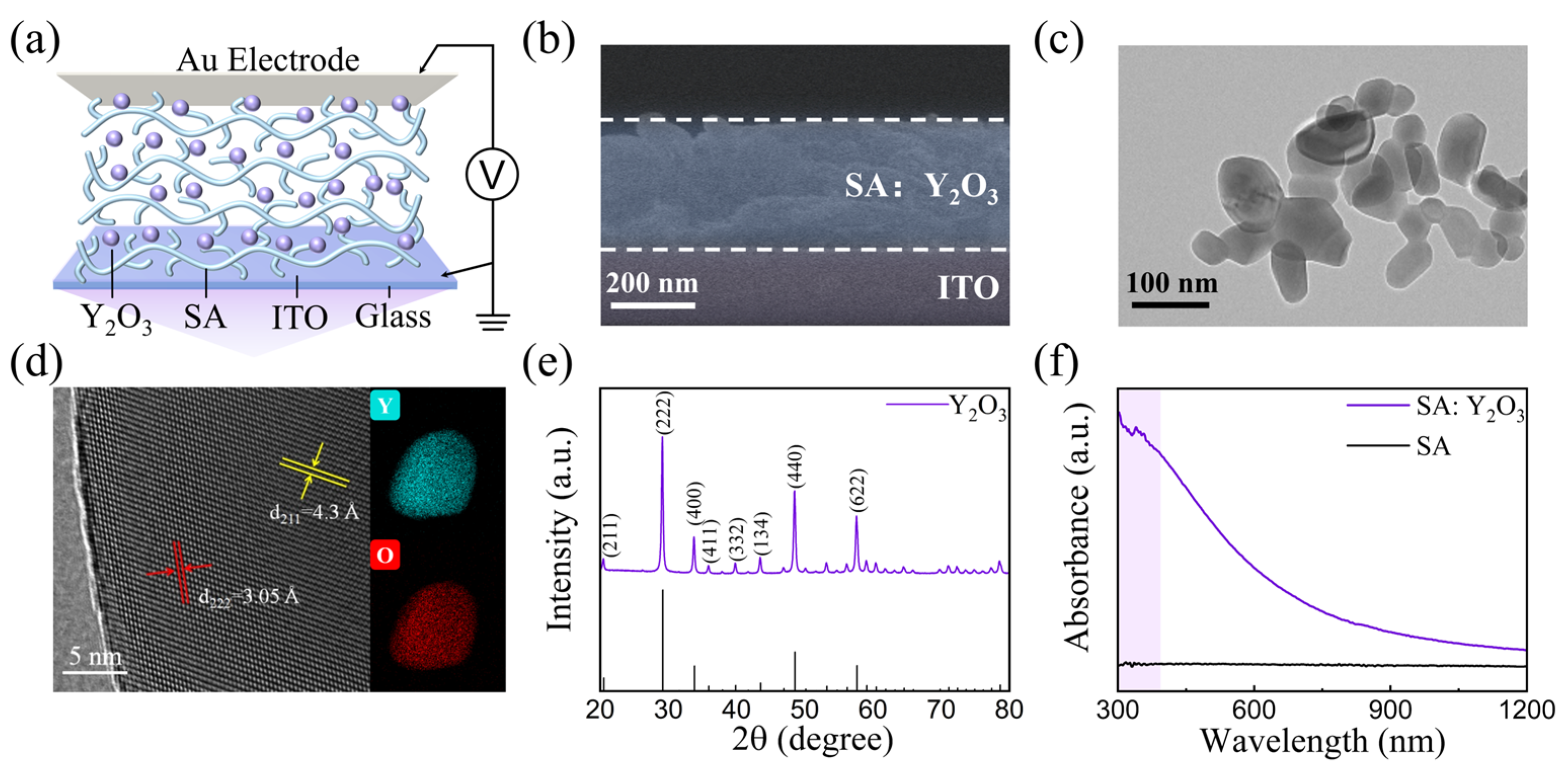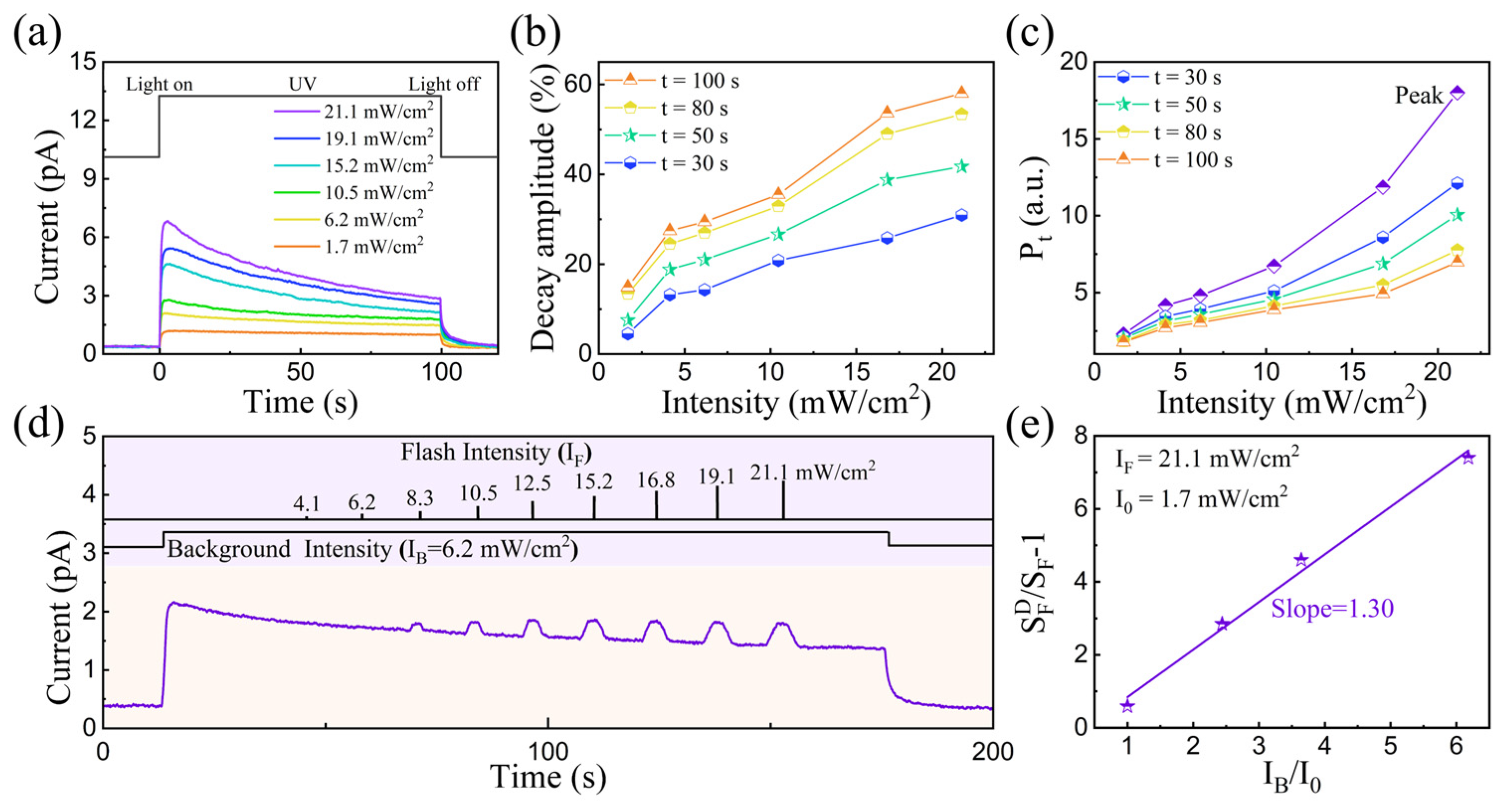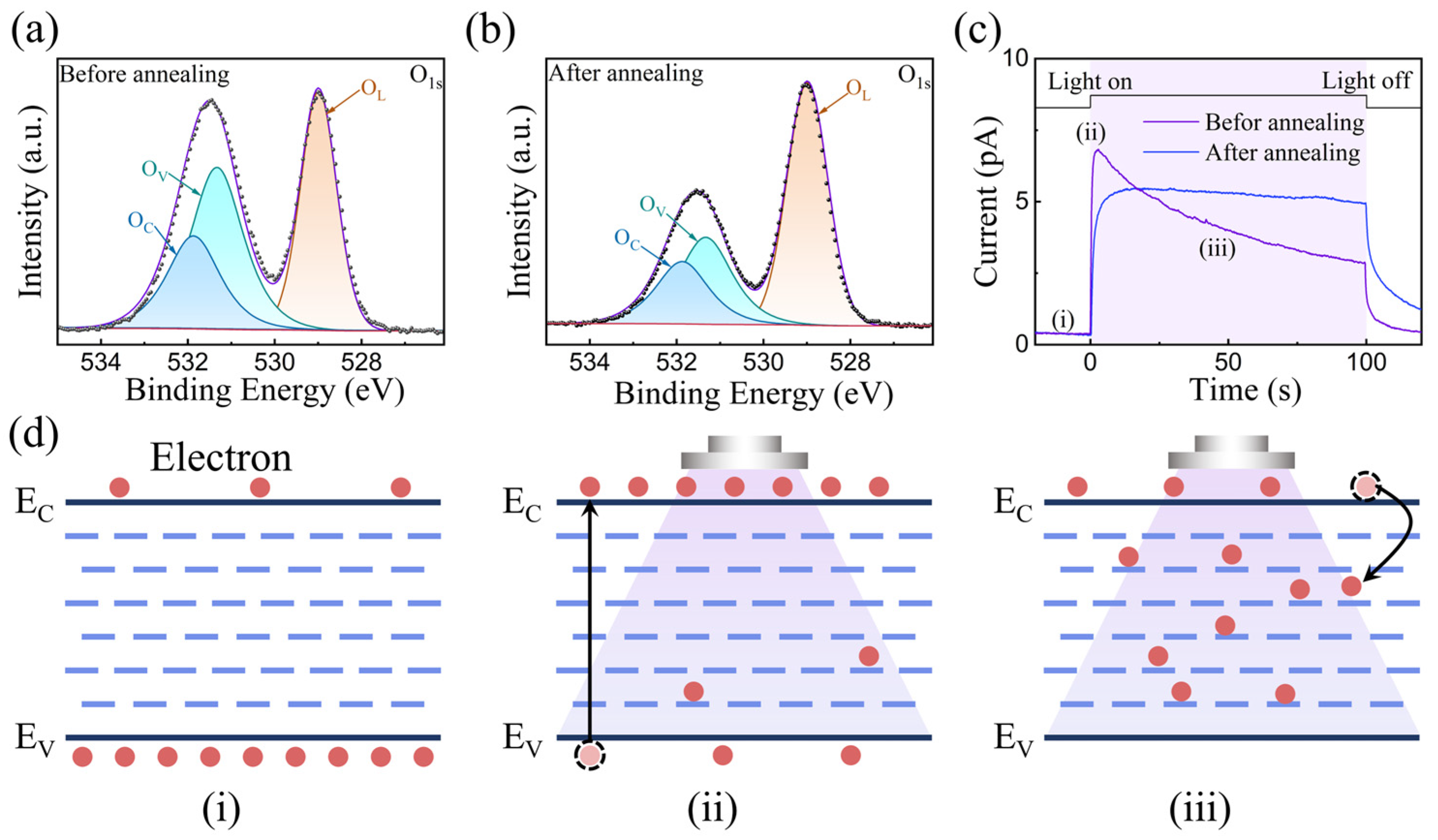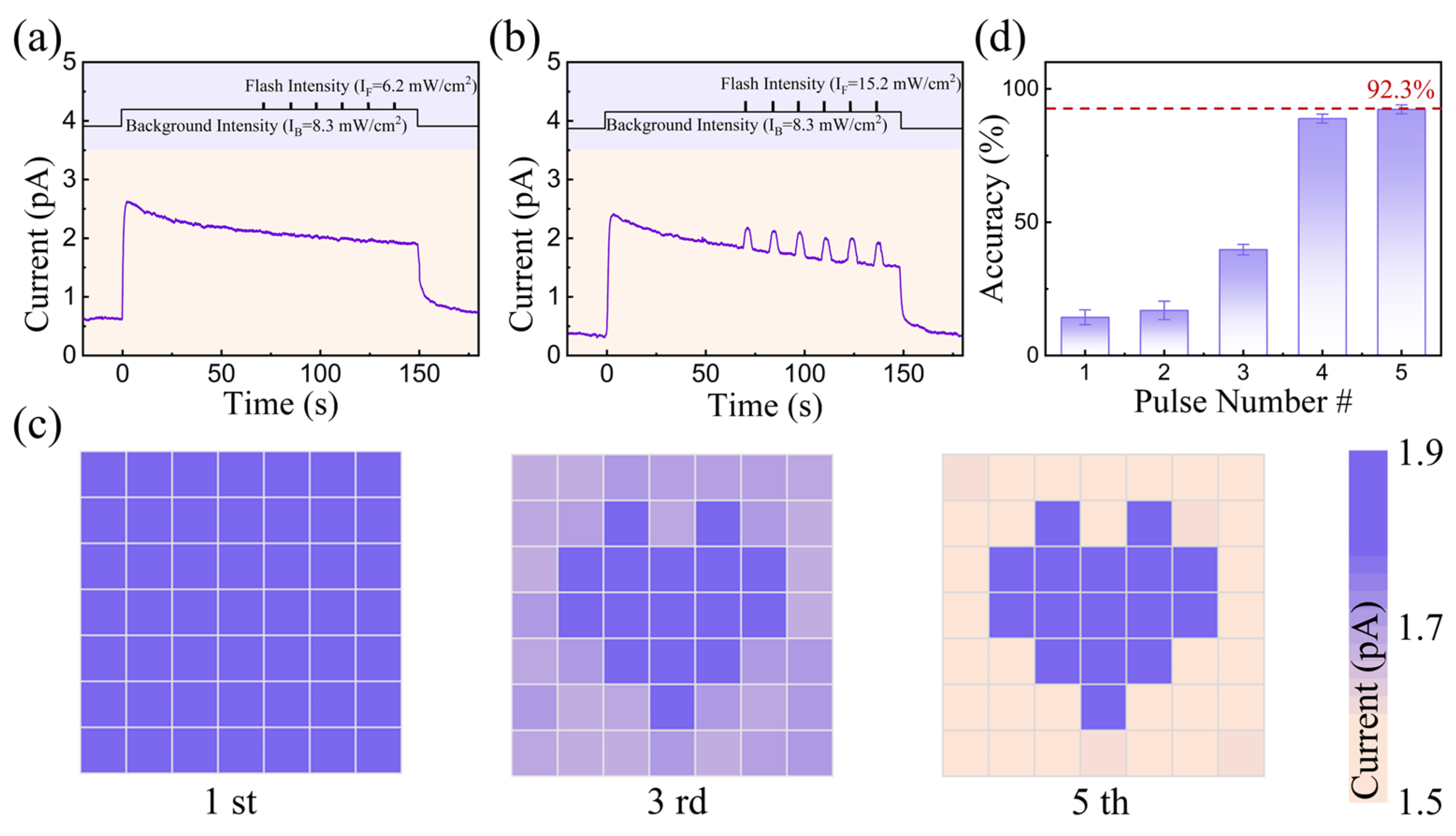Photopic Adaptation Mimicked by Y2O3-Based Optoelectronic Memristor for Neuromorphic Visual System
Abstract
1. Introduction
2. Materials and Methods
3. Results and Discussion
4. Conclusions
Supplementary Materials
Author Contributions
Funding
Data Availability Statement
Conflicts of Interest
References
- Zhu, Q.; Li, B.; Yang, D.; Liu, C.; Feng, S.; Chen, M.; Sun, Y.; Tian, Y.; Su, X.; Wang, X.; et al. A flexible ultrasensitive optoelectronic sensor array for neuromorphic vision systems. Nat. Commun. 2021, 12, 1798. [Google Scholar] [CrossRef] [PubMed]
- Kim, M.S.; Kim, M.S.; Lee, G.J.; Sunwoo, S.H.; Chang, S.; Song, Y.M.; Kim, D.H. Bio-Inspired Artificial Vision and Neuromorphic Image Processing Devices. Adv. Mater. Technol. 2022, 7, 2100144. [Google Scholar] [CrossRef]
- Choi, C.; Lee, G.J.; Chang, S.; Song, Y.M.; Kim, D.H. Inspiration from Visual Ecology for Advancing Multifunctional Robotic Vision Systems: Bio-inspired Electronic Eyes and Neuromorphic Image Sensors. Adv. Mater. 2024, 36, 2412252. [Google Scholar] [CrossRef]
- Bian, J.; Liu, Z.; Tao, Y.; Wang, Z.; Zhao, X.; Lin, Y.; Xu, H.; Liu, Y. Advances in memristor based artificial neuron fabrication-materials, models, and applications. Int. J. Extrem. Manuf. 2024, 6, 012002. [Google Scholar] [CrossRef]
- Jiang, J.; Shan, X.; Xu, J.; Sun, Y.; Xiang, T.F.; Li, A.; Sasaki, S.; Tamiaki, H.; Wang, Z.; Wang, X.F. Retina-Like Chlorophyll Heterojunction-Based Optoelectronic Memristor with All-Optically Modulated Synaptic Plasticity Enabling Neuromorphic Edge Detection. Adv. Funct. Mater. 2024, 34, 2409677. [Google Scholar] [CrossRef]
- Chai, Y. In-sensor computing for machine vision. Nature 2020, 579, 32–33. [Google Scholar] [CrossRef]
- Wang, T.Y.; Meng, J.L.; Li, Q.X.; He, Z.Y.; Zhu, H.; Ji, L.; Sun, Q.-Q.; Chen, L.; Zhang, D.W. Reconfigurable optoelectronic memristor for in-sensor computing applications. Nano Energy 2021, 89, 106291. [Google Scholar] [CrossRef]
- Zhou, F.; Chai, Y. Near-sensor and in-sensor computing. Nat. Electron. 2020, 3, 664–671. [Google Scholar] [CrossRef]
- Sun, L.; Qu, S.; Du, Y.; Yang, L.; Li, Y.; Wang, Z.; Xu, W. Bio-inspired vision and neuromorphic image processing using printable metal oxide photonic synapses. ACS Photonics 2022, 10, 242–252. [Google Scholar] [CrossRef]
- Shooshtari, M.; Través, M.J.; Pahlavan, S.; Serrano-Gotarredona, T.; Linares-Barranco, B. Applying Hodgkin-huxley neuron model for perovskite memristor in circuit simulation. In Proceedings of the 2024 IEEE International Conference on Metrology for Extended Reality, Artificial Intelligence and Neural Engineering, Saint Albans, UK, 21–23 October 2024; IEEE: New York, NY, USA, 2024; pp. 1077–1082. [Google Scholar] [CrossRef]
- Wan, T.; Shao, B.; Ma, S.; Zhou, Y.; Li, Q.; Chai, Y. In-sensor computing: Materials, devices, and integration technologies. Adv. Mater. 2023, 35, 2203830. [Google Scholar] [CrossRef]
- Ren, Q.; Zhu, C.; Ma, S.; Wang, Z.; Yan, J.; Wan, T.; Yan, W.; Chai, Y. Optoelectronic Devices for In-Sensor Computing. Adv. Mater. 2024, 2407476. [Google Scholar] [CrossRef] [PubMed]
- Yang, Q.; Luo, Z.D.; Zhang, D.; Zhang, M.; Gan, X.; Seidel, J.; Liu, Y.; Hao, Y.; Han, G. Controlled Optoelectronic Response in van der Waals Heterostructures for In-Sensor Computing. Adv. Funct. Mater. 2022, 32, 202207290. [Google Scholar] [CrossRef]
- Kohn, A. Visual adaptation: Physiology, mechanisms, and functional benefits. J. Neurophysiol. 2007, 97, 3155–3164. [Google Scholar] [CrossRef]
- Webster, A.M. Visual adaptation. Annu. Rev. Vis. Sci. 2015, 1, 547–567. [Google Scholar] [CrossRef] [PubMed]
- Laughlin, S.B. The role of sensory adaptation in the retina. J. Exp. Biol. 1989, 146, 39–62. [Google Scholar] [CrossRef]
- Rasengane, T.A.; Palmer, J.; Teller, D.Y. Infant light adaptation shows Weber’s law at photopic illuminances. Vision Res. 2001, 41, 359–373. [Google Scholar] [CrossRef]
- Hecht, S. The visual discrimination of intensity and the Weber-Fechner law. J. Gen. Physiol. 1924, 7, 235. [Google Scholar] [CrossRef]
- Sakmann, B.; Creutzfeldt, O.D. Scotopic and mesopic light adaptation in the cat’s retina. Pflugers. Arch. 1969, 313, 168–185. [Google Scholar] [CrossRef]
- Liu, S.C. Silicon retina with adaptive filtering properties. NeurIPS 1997, 10, 712–718. [Google Scholar]
- Mahowald, M.A. Silicon retina with adaptive photoreceptors/Visual information processing: From neurons to chips. SPIE 1991, 1473, 52–58. [Google Scholar] [CrossRef]
- Liu, W.; Yang, X.; Wang, Z.; Li, Y.; Li, J.; Feng, Q.; Xie, X.; Xin, W.; Xu, H.; Liu, Y. Self-powered and broadband opto-sensor with bionic visual adaptation function based on multilayer γ-InSe flakes. Light Sci. Appl. 2023, 12, 180. [Google Scholar] [CrossRef]
- He, Z.; Shen, H.; Ye, D.; Xiang, L.; Zhao, W.; Ding, J.; Zhang, F.; Di, C.; Zhu, D. An organic transistor with light intensity-dependent active photoadaptation. Nat. Electron. 2021, 4, 522–529. [Google Scholar] [CrossRef]
- Xie, D.; Wei, L.; Xie, M.; Jiang, L.; Yang, J.; He, J.; Jiang, J. Photoelectric visual adaptation based on 0D-CsPbBr3-quantum-dots/2D-MoS2 mixed-dimensional heterojunction transistor. Adv. Funct. Mater. 2021, 31, 2010655. [Google Scholar] [CrossRef]
- He, Z.; Ye, D.; Liu, L.; Di, C.A.; Zhu, D. Advances in materials and devices for mimicking sensory adaptation. Mater. Horiz. 2022, 9, 147–163. [Google Scholar] [CrossRef] [PubMed]
- Liao, F.; Zhou, Z.; Kim, B.J.; Chen, J.; Wang, J.; Wan, T.; Zhou, Y.; Hoang, A.T.; Wang, C.; Kang, J.; et al. Bioinspired in-sensor visual adaptation for accurate perception. Nat. Electron. 2022, 5, 84–91. [Google Scholar] [CrossRef]
- Shruthi, J.; Jayababu, N.; Reddy, M.V.R. Synthesis of Y2O3-ZnO nanocomposites for the enhancement of room temperature 2-methoxyethanol gas sensing performance. J. Alloy. Compd. 2019, 798, 438–445. [Google Scholar] [CrossRef]
- Ansari, A.A.; Khan, A.; Labis, J.P.; Alam, M.; Aslam Manthrammel, M.; Ahamed, M.; Akhtar, M.J.; Aldalbahi, A.; Ghaithan, H. Mesoporous multi-silica layer-coated Y2O3: Eu core-shell nanoparticles: Synthesis, luminescent properties and cytotoxicity evaluation. Mater. Sci. Eng. C. 2019, 96, 365–373. [Google Scholar] [CrossRef]
- Porosnicu, I.; Butnaru, C.M.; Tiseanu, I.; Stancu, E.; Munteanu, C.V.A.; Bita, B.I.; Duliu, O.G.; Sima, F. Y2O3 nanoparticles and X-ray radiation-induced effects in melanoma cells. Molecules 2021, 26, 3403. [Google Scholar] [CrossRef]
- Louis, A.J.; Abdulridha, A.R. Preparation of (PVA/Y2O3) Nanocomposite and Study the Optical Properties for Optoelectronic Device. J. Surv. Fish. Sci. 2023, 10, 887–894. [Google Scholar]
- Borrás, M.C.; Sluyter, R.; Barker, P.J.; Konstantinov, K.; Bakand, S. Y2O3 decorated TiO2 nanoparticles: Enhanced UV attenuation and suppressed photocatalytic activity with promise for cosmetic and sunscreen applications. J. Photochem. Photobiol. B Biol. 2020, 207, 111883. [Google Scholar] [CrossRef]
- Kim, H.J.; Kim, D.W.; Lee, W.Y.; Kim, K.; Lee, S.H.; Bae, J.H.; Kang, I.M.; Kim, K.; Jang, J. Flexible Sol-Gel—Processed Y2O3 RRAM Devices Obtained via UV/Ozone-Assisted Photochemical Annealing Process. Materials 2022, 15, 1899. [Google Scholar] [CrossRef] [PubMed]
- Ernst, W.; Kemp, C.M. Scotopic and photopic dark adaptation of the b wave in isolated rat retina. Nature 1975, 258, 170–171. [Google Scholar] [CrossRef]
- Jacobs, G.H.; Fisher, S.K.; Anderson, D.H.; Silverman, M.S. Scotopic and photopic vision in the California ground squirrel: Physiological and anatomical evidence. J. Comp. Neurol. 1976, 165, 209–227. [Google Scholar] [CrossRef]
- Shi, L.; Shi, K.; Zhang, Z.C.; Li, Y.; Wang, F.D.; Si, S.H.; Liu, Z.B.; Lu, T.B.; Chen, X.D.; Zhang, J. Flexible retinomorphic vision sensors with scotopic and photopic adaptation for a fully flexible neuromorphic machine vision system. SmartMat 2024, 5, e1285. [Google Scholar] [CrossRef]
- Shen, H.; He, Z.; Jin, W.; Xiang, L.; Zhao, W.; Di, C.A.; Zhu, D. Mimicking Sensory Adaptation with Dielectric Engineered Organic Transistors. Adv. Mater. 2019, 31, 1905018. [Google Scholar] [CrossRef] [PubMed]
- Shi, J.; Lin, Y.; Wang, Z.; Shan, X.; Tao, Y.; Zhao, X.; Xu, H.; Liu, Y. Adaptive processing enabled by sodium alginate based complementary memristor for neuromorphic sensory system. Adv. Mater. 2024, 36, 2314156. [Google Scholar] [CrossRef]
- Fain, G.L.; Matthews, H.R.; Cornwall, M.C.; Koutalos, Y. Adaptation in vertebrate photoreceptors. Physiol. Rev. 2001, 81, 117–151. [Google Scholar] [CrossRef]
- Matthews, H.R. Incorporation of chelator into guinea-pig rods shows that calcium mediates mammalian photoreceptor light adaptation. J. Physiol. 1991, 436, 93–105. [Google Scholar] [CrossRef]
- Chen, J.Y.; Huang, C.W.; Chiu, C.H.; Huang, Y.T.; Wu, W.W. Switching kinetic of VCM-based memristor: Evolution and positioning of nanofilament. Adv. Mater. 2015, 27, 5028–5033. [Google Scholar] [CrossRef]
- Zhang, K.; Li, T.; Liu, X.; Huang, Z.; Liu, Y. The formation process and influencing factors of electric field-induced oxygen vacancy in Y2O3 transparent ceramic. Ceram. Int. 2024, 50, 41417–41425. [Google Scholar] [CrossRef]
- Zhang, R.; Lin, Z.; Chen, N.; Zhao, D.; Chen, Q. Oxygen vacancy–enriched Y2O3 nanoparticles having reactive facets for selective sensing of methyl ethyl ketone peroxide explosive. Sens. Actuator B Chem. 2024, 403, 135138. [Google Scholar] [CrossRef]
- Lee, T.; Kim, H.I.; Cho, Y.; Lee, S.; Lee, W.Y.; Bae, J.H.; Kang, I.M.; Kim, K.; Lee, S.H.; Jang, J. Sol–Gel-Processed Y2O3 Multilevel Resistive Random-Access Memory Cells for Neural Networks. Nanomaterials 2023, 13, 2432. [Google Scholar] [CrossRef] [PubMed]
- Geng, X.; Hu, L.; Zhuge, F.; Wei, X. Retina-Inspired Two-Terminal Optoelectronic Neuromorphic Devices with Light-Tunable Short-Term Plasticity for Self-Adjusting Sensing. Adv. Intell. Syst. 2022, 4, 2200019. [Google Scholar] [CrossRef]
- Wang, J.; Pan, R.; Cao, H.; Wang, Y.; Liang, L.; Zhang, H.; Gao, J.; Zhuge, F. Anomalous rectification in a purely electronic memristor. Appl. Phys. Lett. 2016, 109, 143505. [Google Scholar] [CrossRef]
- Pan, R.; Li, J.; Zhuge, F.; Zhu, L.; Liang, L.; Zhang, H.; Gao, J.; Cao, H.; Fu, B.; Li, K. Synaptic devices based on purely electronic memristors. Appl. Phys. Lett. 2016, 108, 013504. [Google Scholar] [CrossRef]




Disclaimer/Publisher’s Note: The statements, opinions and data contained in all publications are solely those of the individual author(s) and contributor(s) and not of MDPI and/or the editor(s). MDPI and/or the editor(s) disclaim responsibility for any injury to people or property resulting from any ideas, methods, instructions or products referred to in the content. |
© 2025 by the authors. Licensee MDPI, Basel, Switzerland. This article is an open access article distributed under the terms and conditions of the Creative Commons Attribution (CC BY) license (https://creativecommons.org/licenses/by/4.0/).
Share and Cite
Shi, J.; Qiao, S.; Shan, X.; Li, Z.; Li, Z.; Wang, C.; Tao, Y.; Zhao, X.; Lin, Y.; Wang, Z. Photopic Adaptation Mimicked by Y2O3-Based Optoelectronic Memristor for Neuromorphic Visual System. Nanomaterials 2025, 15, 579. https://doi.org/10.3390/nano15080579
Shi J, Qiao S, Shan X, Li Z, Li Z, Wang C, Tao Y, Zhao X, Lin Y, Wang Z. Photopic Adaptation Mimicked by Y2O3-Based Optoelectronic Memristor for Neuromorphic Visual System. Nanomaterials. 2025; 15(8):579. https://doi.org/10.3390/nano15080579
Chicago/Turabian StyleShi, Jiajuan, Shanshan Qiao, Xuanyu Shan, Zhuangzhuang Li, Zhipeng Li, Chunliang Wang, Ye Tao, Xiaoning Zhao, Ya Lin, and Zhongqiang Wang. 2025. "Photopic Adaptation Mimicked by Y2O3-Based Optoelectronic Memristor for Neuromorphic Visual System" Nanomaterials 15, no. 8: 579. https://doi.org/10.3390/nano15080579
APA StyleShi, J., Qiao, S., Shan, X., Li, Z., Li, Z., Wang, C., Tao, Y., Zhao, X., Lin, Y., & Wang, Z. (2025). Photopic Adaptation Mimicked by Y2O3-Based Optoelectronic Memristor for Neuromorphic Visual System. Nanomaterials, 15(8), 579. https://doi.org/10.3390/nano15080579





